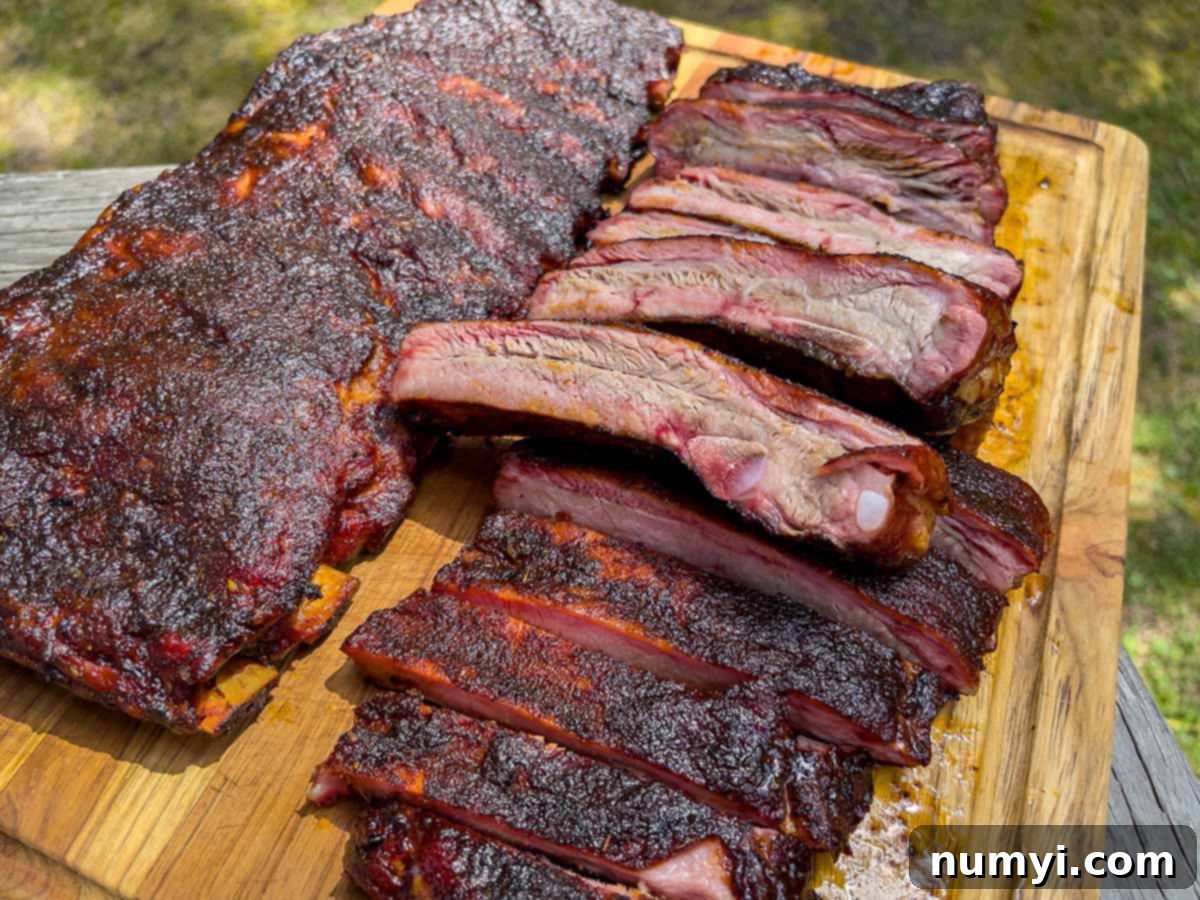Mastering St. Louis Ribs: The Ultimate Mop-Basting Guide for Perfectly Smoked Ribs (No Wrapping!)
Unlock the secret to creating the most incredible St. Louis Style ribs you’ve ever tasted. Our simple mop-basting technique promises amazingly tender, deeply flavorful pork ribs without the need for wrapping. Prepare yourself for a barbecue experience that’s truly a game-changer.
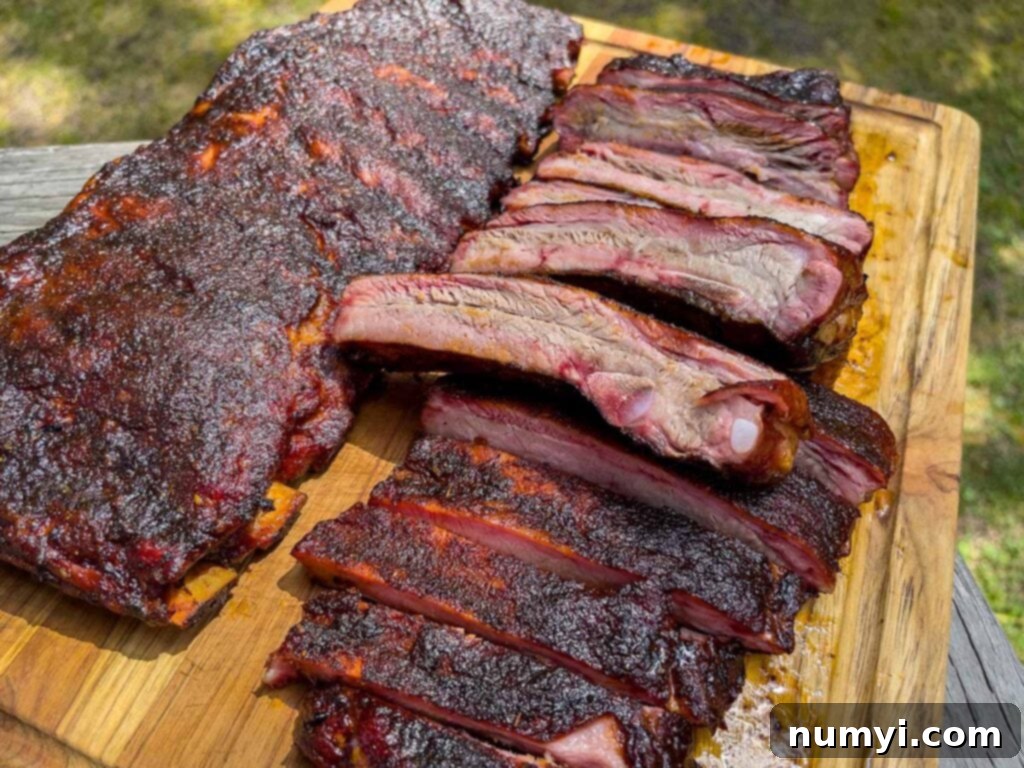
Why You Will Love These St. Louis Ribs
Smoked ribs are a quintessential element of any backyard barbecue, sparking endless debates among enthusiasts about the perfect temperature, cooking time, wood type, and that elusive “fall-off-the-bone” versus “clean-bite” texture. These varying opinions can be overwhelming for even seasoned grill masters.
However, one thing remains undeniably true: this particular recipe consistently delivers truly exceptional smoked pork ribs. You’ll savor a profound smokiness complemented by a hint of spice and a touch of sweetness. The result is a rib that offers a satisfying tug with a clean bite – the hallmark of perfect smoked ribs, far from the texture of pulled pork.
For this specific St. Louis ribs recipe, we’re embracing a no-wrap approach. Instead of wrapping the ribs in foil, we’ll baste them diligently with a flavorful mop every 30 minutes. This method achieves a tender, juicy rib without causing them to become overly mushy. Our goal isn’t ribs that disintegrate upon touch, but rather ones with a pleasant resistance and a clean separation from the bone.
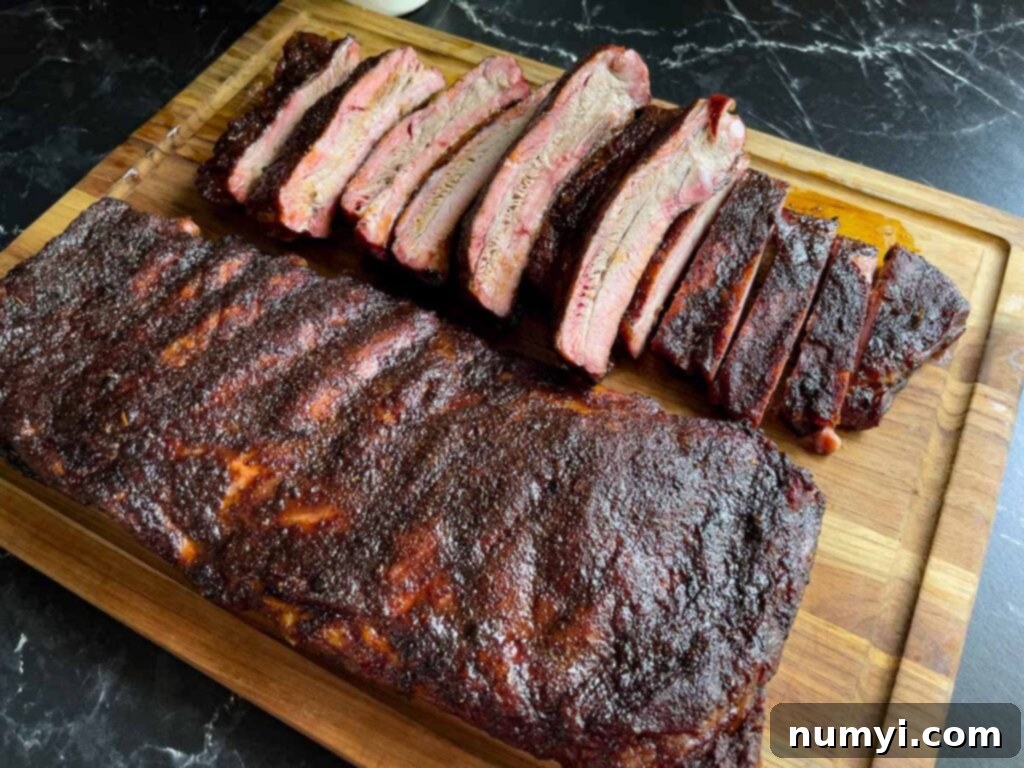
Don’t Sweat The Recipe is supported by its readers. We may earn a commission if you purchase through a link on our site. Learn more.
The flavorful mop we’re using works wonders, adding incredible depth and complexity to the ribs while consistently keeping them moist. This technique achieves the perfect tenderness and flavor without relying on wrapping, which can sometimes lead to an undesirable texture.
A crucial point to remember for any aspiring pitmaster: steer clear of the infamous 3-2-1 method for smoking ribs. While some advocate for it, serious barbecue enthusiasts generally advise against it, as it commonly results in ribs that are overcooked and have the consistency of pulled pork, rather than the desired clean bite. If you’re seeking ribs that literally fall off the bone, we have a popular Fall Off The Bone St. Louis Style Ribs recipe, but even that doesn’t require a 6-hour cook!
What Exactly Are St. Louis Style Ribs?
St. Louis style ribs are essentially pork spareribs, also known as side ribs. They are cut from the belly section of the pig’s rib cage, positioned beneath the loin (where back ribs come from) and above the sternum or breast bone. Spareribs are characterized by their flatter profile and higher bone-to-meat ratio compared to other rib cuts, though they boast a rich fat content that contributes significantly to their tenderness and flavor.
What distinguishes spareribs as “St. Louis style” is the specific butchering process. This involves removing the sternum bone, cartilage, and irregular rib tips, resulting in a neat, nearly rectangular slab of ribs. This uniform shape isn’t just for aesthetics; it promotes more even cooking and makes for a more presentable plate, ideal for competitive barbecue and home cooks alike.
What’s the Difference Between Baby Back Ribs And St. Louis Style Ribs?
Understanding the distinction between baby back ribs and St. Louis style ribs is key to appreciating their unique characteristics and preparing them appropriately:
- Baby Back Ribs: These ribs originate from the top of the rib cage, nestled between the spine and the spareribs. They are typically shorter, more curved, and often meatier than spareribs, with meat found both between and on top of the bones. Their leanness means they cook faster but can dry out if not managed carefully.
- St. Louis Style Ribs (Spareribs): As discussed, these are the trimmed spareribs from the pig’s belly. While they contain more bone, they also possess a higher fat content. This extra marbling is a secret weapon, rendering down during the smoking process to produce exceptionally tender, juicy, and flavorful ribs that are less prone to drying out than their leaner baby back counterparts. This fat also contributes to a richer, more succulent bite.
Both types offer a delightful experience, but St. Louis style ribs are often preferred for their robust flavor and forgiving nature on the smoker, especially with our no-wrap mop method.
How To Smoke St. Louis Ribs Like a Pro
Smoking ribs successfully is all about methodical preparation and timing. By breaking the process down into manageable steps, you ensure everything is ready when it needs to be, leading to a smooth and enjoyable barbecue experience.
- Prepare the dry rub for maximum flavor.
- Prepare the ribs through trimming and membrane removal.
- Prepare the mop sauce for basting.
- Smoke the ribs to tender perfection.
- Rest, slice, and savor your delicious ribs.
Step 1: Prepare Your Signature Dry Rub
The dry rub is the foundation of flavor for your smoked St. Louis ribs. The options for rubs are vast, and many pitmasters have their tried-and-true favorites. If you already have a go-to rub you love, fantastic – feel free to skip ahead to preparing the ribs. If you’re new to the world of rubs or looking for a reliable, no-fuss option, Bad Byron’s Butt Rub is an excellent commercial choice, especially for pork. It features classic ingredients like paprika, salt, pepper, onion powder, garlic powder, and chipotle powder, offering a very decent flavor profile without any added sugar, making it suitable for those on a Keto diet.
However, we firmly believe that making your own rub is where the magic truly happens! It allows you to customize the flavor balance and, let’s be honest, take full credit for the phenomenal barbecue you’re about to serve.
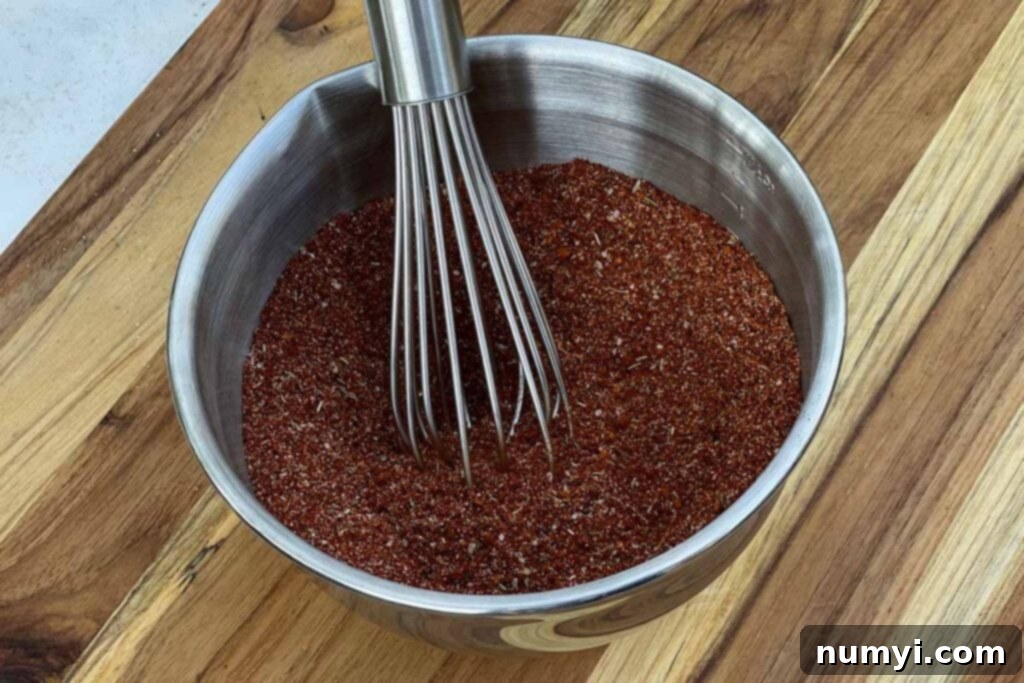
Our preferred rub leans towards a Memphis-style profile – not overly sweet, with a gentle, balanced heat that perfectly complements pork. To prepare this exquisite rub, simply combine all the ingredients listed in the recipe card below in a bowl. Whisk them thoroughly to ensure an even distribution of flavors. Once combined, you can either sprinkle it directly onto the ribs or transfer it to a spice shaker for easier application. The goal is to achieve a consistent coating that will form a beautiful, flavorful bark.
With your custom rub ready, it’s time to turn your attention to the star of the show: the ribs themselves.
Step 2: Preparing the St. Louis Style Ribs
You have a couple of options when purchasing your ribs. You can buy full racks of pork spareribs and trim them yourself into the St. Louis style cut, or you can often find them already pre-trimmed at your butcher or grocery store. When considering which to buy, always compare prices. Trimming a full rack means you’ll remove a significant amount of weight in bone and fat, so calculate if the cost savings are worth the extra effort. Often, pre-trimmed St. Louis ribs can be a more economical and time-saving choice.
Trimming Excess Fat for Optimal Flavor
Trimming excess fat is a critical step that many overlook. While a certain amount of fat is essential for moisture and flavor, excessive, unrendered fat can create a greasy texture and, more importantly, act as a barrier. This barrier prevents your delicious rub and the smoky goodness from penetrating the meat, resulting in a less flavorful rib. Some ribs, like those often found at Costco, are usually well-trimmed, but there are always areas that need attention.
Carefully inspect your ribs for any large, thick pockets of fat or any small, dangling bits of pork around the edges. These should be trimmed off. The goal is to achieve a relatively uniform fat cap, typically no more than 1/4 inch thick. You can use your finger to press on fatty areas; if it feels dense and rubbery, it’s likely not going to render properly and should be removed.
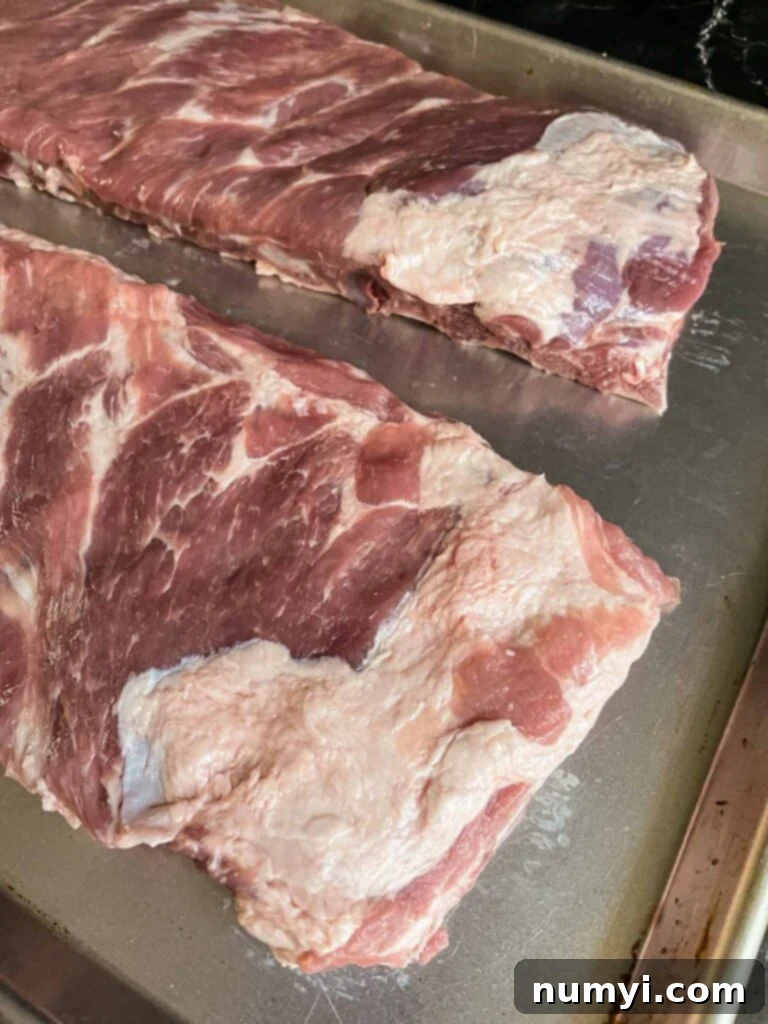
Using a sharp, flexible knife (a boning or filet knife works best), carefully slice away these fatty sections. Take your time, making shallow cuts to avoid cutting into the precious rib meat. Remember, an even cook and optimal smoke penetration depend on a properly trimmed rack.

The amount of trimming required will vary greatly from one rack of ribs to another. Some may need extensive work, while others might only require minor adjustments. Always check your ribs thoroughly when purchasing, as extensive trimming directly impacts the actual cost per pound of meat. Once your ribs are properly trimmed of excess fat, you’re ready to proceed with cutting them into the St. Louis style, if they aren’t already. If they are already St. Louis style, you can jump ahead to applying the rub.
Removing The Back Flap (Diaphragm) for Even Cooking
Next, flip your ribs over to expose the bone side. You’ll often find a thin, elongated strip of meat running roughly halfway along the length of the rack. This is the diaphragm, also known as the skirt or back flap. It’s crucial to trim this piece off because it’s significantly thinner than the rest of the rib meat and will cook much faster, leading to an overcooked, dry, and chewy section. Removing it ensures a more uniform cook across the entire rack.
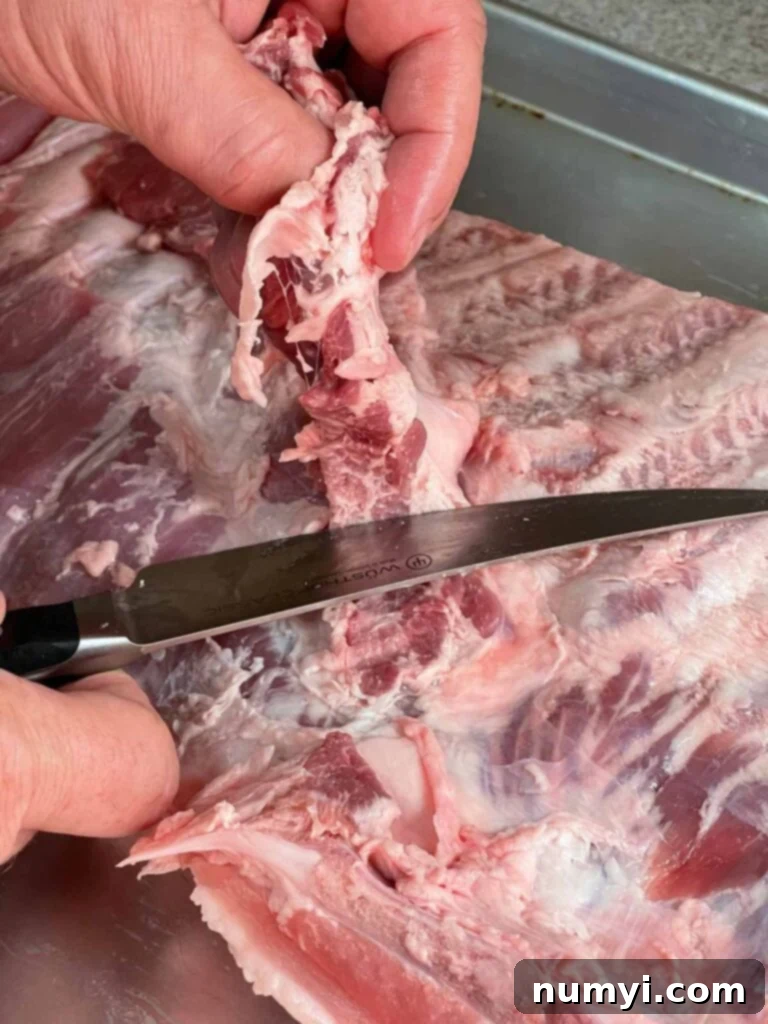
Carefully trim this flap using your sharp knife. Don’t discard it! This is a flavorful piece of pork that can be reserved for other culinary uses, such as enhancing stews, making stock, or even seasoning other dishes.
Removing The Membrane (Silver Skin) from the Ribs
Another non-negotiable step is removing the thin, silvery membrane (often called silver skin) on the bone side of the ribs. This membrane is a tough layer of connective tissue that will not render or break down during cooking. If left intact, it creates a chewy barrier that prevents both your rub and the smoke from fully permeating the meat. Furthermore, it hinders that desirable “clean bite” experience; instead of a tender tear, you’ll find yourself struggling to pull the meat off the bone.
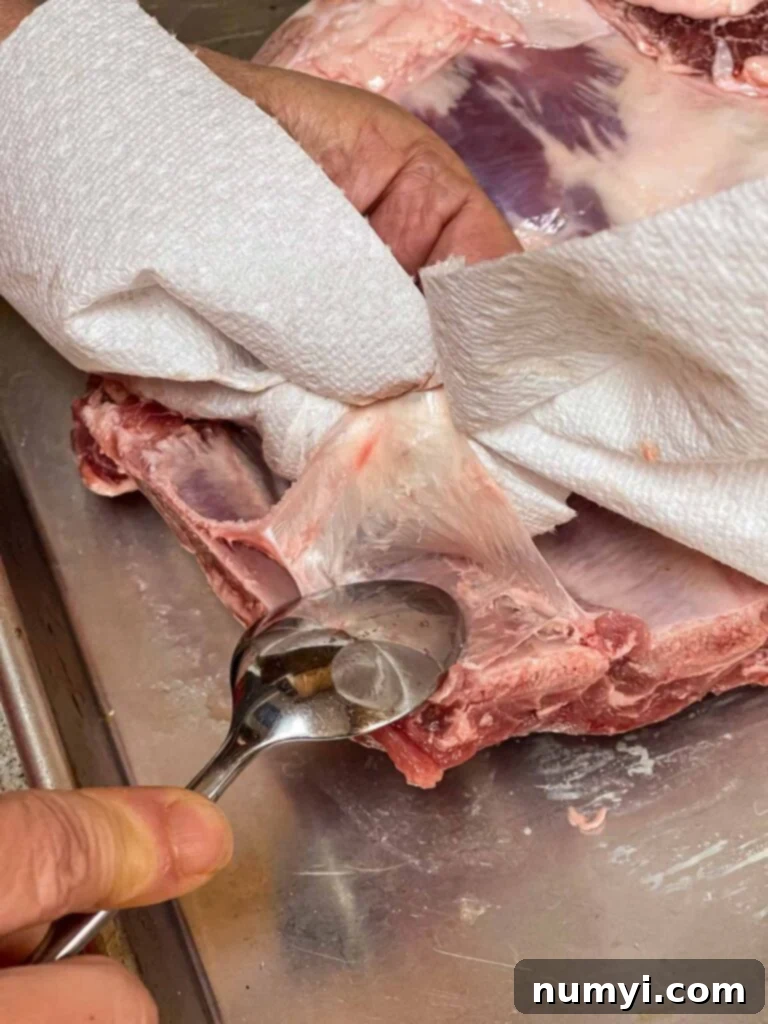
To remove the silver skin, turn the ribs bone-side up. Using a spoon handle, a butter knife, or even your finger, carefully slip it under the membrane at one corner of the rack and gently pry it up until you can get a good grip. Once you have a loose edge, grab it firmly with a paper towel (this provides a much better grip than bare hands) and pull it steadily down the length of the rack. If it tears, simply repeat the process from where it broke. Persistence is key, and it gets easier with practice. This step dramatically improves the texture and flavor absorption of your smoked ribs.
Removing The Brisket Bone (for St. Louis Cut)
If you started with a full rack of spareribs and not a pre-trimmed St. Louis cut, this is the step where you transform them into the desired rectangular shape. This involves removing the brisket bone (sternum), the surrounding cartilage, and the rib tips. This cut is essential for achieving the uniform thickness and shape that defines St. Louis style ribs, ensuring a consistent cook and a beautiful presentation.

To make the cut, first locate the longest rib bone on the rack, which is typically the fourth bone from the end that would connect to the brisket. This will be your guide. You will make a lengthwise cut directly down the rack, following the natural curve where the rib bones begin to angle sharply. Use a very sharp knife and apply steady pressure. You may encounter some resistance when cutting through cartilage, but a good knife should glide through.
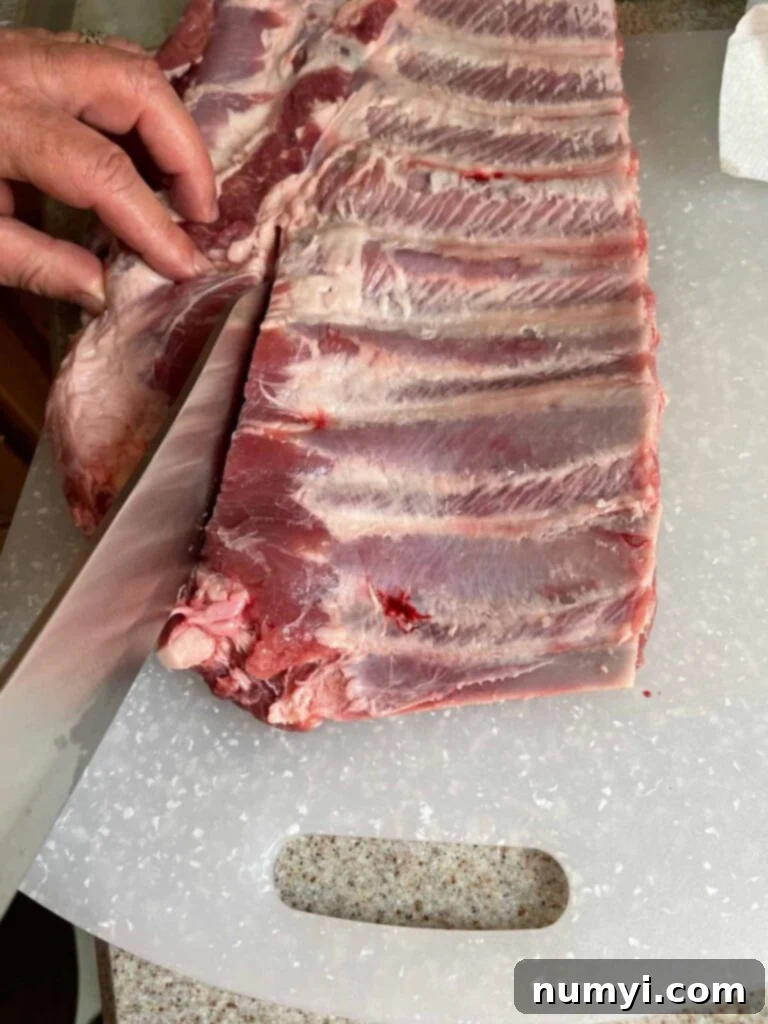
This removed section, often called “rib tips,” is packed with flavor. Don’t let it go to waste! Many pitmasters will smoke these alongside the main ribs. They cook faster due to their smaller size and mixture of meat, bone, and cartilage, making for a fantastic, smoky snack or a flavorful addition to other dishes.
Final Trim for Perfect Uniformity
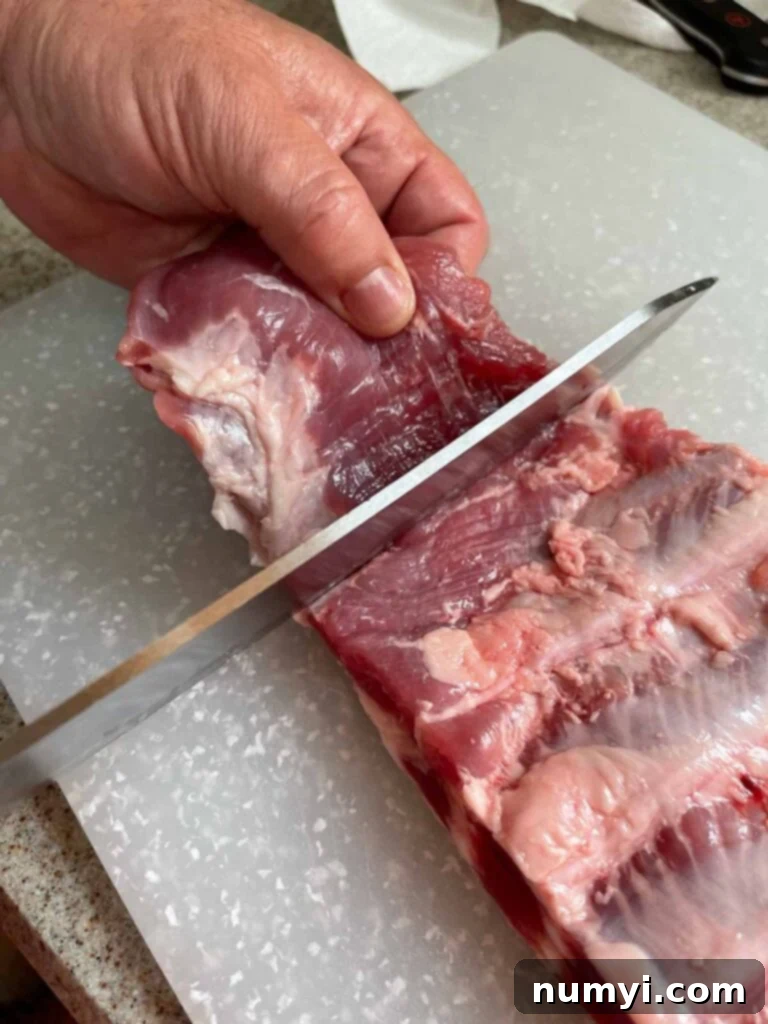
Take one last look at your rib rack. At one end, you might notice a thin, irregular flap of meat. This “flap meat” tends to cook much faster than the rest of the rack and can easily become tough and overcooked. For optimal results and a uniform presentation, trim this section off. Just like the rib tips, this piece can be added to your smoker to create another tasty morsel.
Once you’ve completed all the trimming, flip the rack over and check for any remaining small bits or uneven edges that could benefit from a quick trim. When you’re finished, you should have a beautifully rectangular, uniform rack of St. Louis style ribs, ready for the next delicious step.
Step 3: Liberally Apply the Dry Rub
Now comes the moment to infuse your meticulously prepared ribs with all the aromatic flavors of your dry rub. Place your trimmed ribs on a large baking sheet, bone-side up. This allows for easy access to all surfaces and helps contain any excess rub.
Generously apply the rub to the bone side of the ribs first. Don’t be shy – you want a thorough, even coating. Gently pat the rub into the meat; this helps it adhere and creates a better “bark” during smoking. Once the bone side is fully covered, flip the ribs over and repeat the process on the meatier side, ensuring every inch is coated with that flavorful goodness.
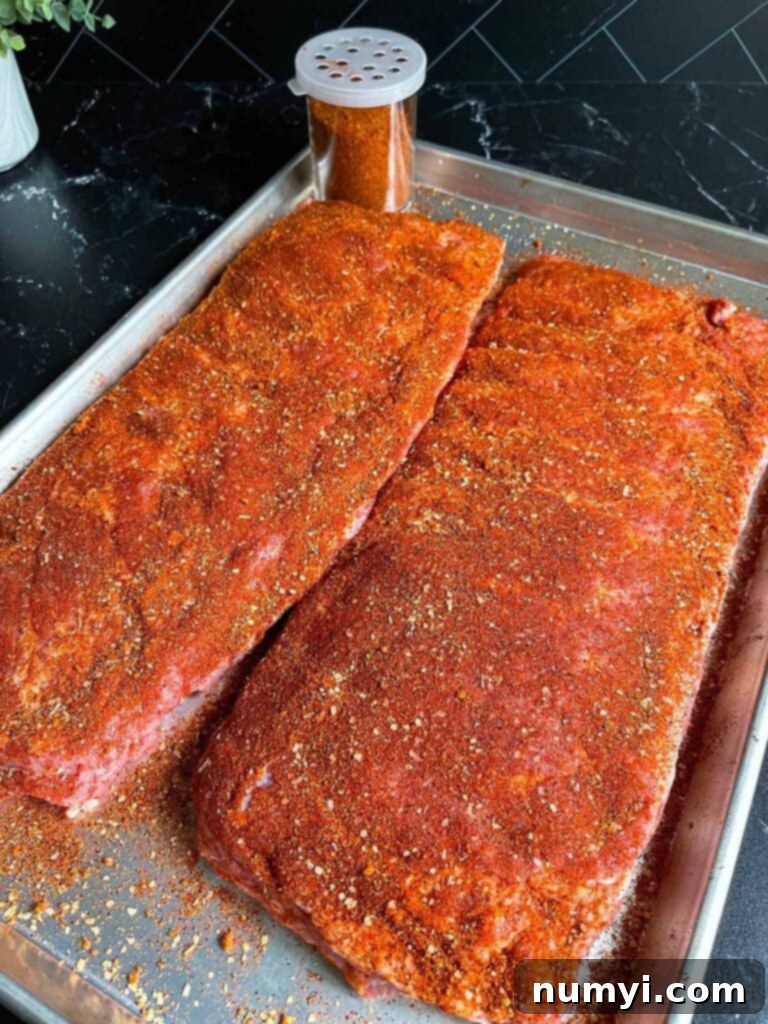
A common debate among barbecue enthusiasts is the use of a “binder,” such as mustard or olive oil, to help the rub stick. While I’ve certainly used binders in the past, I’ve found through extensive experience that a good rub, applied generously and patted down, adheres perfectly well to the natural moisture of the meat without any additional binder. So, for this recipe, feel free to skip the binder if you prefer a simpler approach.
After applying the rub, allow the ribs to rest at room temperature for 30 minutes to one hour. This resting period, often called “sweating,” allows the salt in the rub to draw moisture to the surface of the meat, dissolving the rub and creating a flavorful paste that will stick firmly during smoking. While the ribs are resting, you can move on to preparing your smoker and the all-important mop sauce.
Step 4: Crafting the Flavorful Mop Sauce
As we’ve highlighted, this recipe champions the no-wrap method, and the mop sauce is central to its success. While wrapping ribs in foil can accelerate tenderness, it often leads to a steamed, sometimes overly tender or mushy texture, where the ribs lose their structural integrity and that satisfying “tug.” Our mop-basting technique avoids this, delivering ribs that are tender, juicy, and packed with flavor, all while developing a fantastic smoky bark.
The beauty of the mop lies in its ability to continually add layers of flavor and moisture throughout the smoking process. This, combined with a slightly higher cooking temperature, helps achieve those perfect ribs faster, ensures a beautiful smoke ring, and keeps the meat incredibly moist. Plus, experimenting with mop ingredients allows for endless flavor customization!
Our basic mop recipe is designed to accentuate the savory, smoky notes of the dry rub without overpowering them. It’s a tried-and-true combination that simply works wonders. In a small saucepan, combine the following ingredients:
- 3/4 cup Worcestershire sauce
- 6 tablespoons unsalted butter
- 2 tablespoons apple cider vinegar
- 1 teaspoon Kosher salt
- 1 tablespoon freshly ground black pepper

Gently warm the mixture over low heat, stirring until the butter has fully melted and all ingredients are well combined. Keep the mop warm throughout the smoking process, as warm liquid adheres better to the ribs and helps maintain smoker temperature. This simple yet powerful sauce is your secret weapon for achieving truly memorable smoked St. Louis ribs.
Step 5: Smoking The Ribs to Perfection
The smoking phase is where all your preparation comes to fruition. Debates abound regarding the optimal time and temperature for smoking pork ribs. I’ve experimented with temperatures ranging from a low 225°F to a hotter 275°F. For this no-wrap, mop-basted method, we’ll aim for the higher end of that spectrum. This allows the ribs to cook more efficiently without compromising on smoke penetration, yielding tender ribs in a reasonable timeframe.
Begin by preheating your smoker to a consistent temperature between 250°F and 275°F. Consistency is crucial here, so ensure your smoker is holding temperature steady before introducing the ribs. Once ready, add your preferred smoking wood (more on this below) and carefully place the rubbed ribs in the smoker. Position them bone-side down, with the thicker end of the racks facing towards the primary heat source of your smoker for more even cooking.
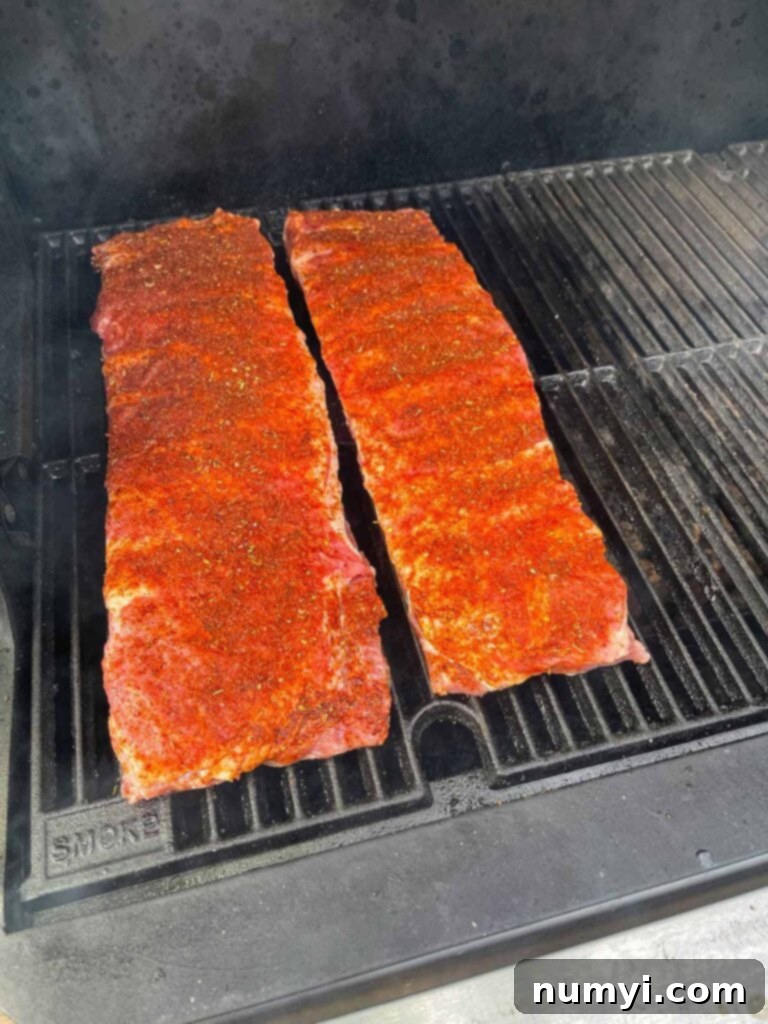
What Wood To Use When Smoking Ribs
The type of wood you choose will significantly impact the flavor profile of your smoked ribs. For a robust, classic barbecue flavor that’s assertive but not overpowering, hickory wood is an excellent choice. Its strong, bacon-like aroma pairs wonderfully with pork. If you prefer a slightly milder, nutty flavor, pecan wood is a fantastic alternative. Oak wood also offers a balanced, medium smoke flavor that is versatile and complements most meats well. For lighter, fruitier notes, consider apple or cherry wood.
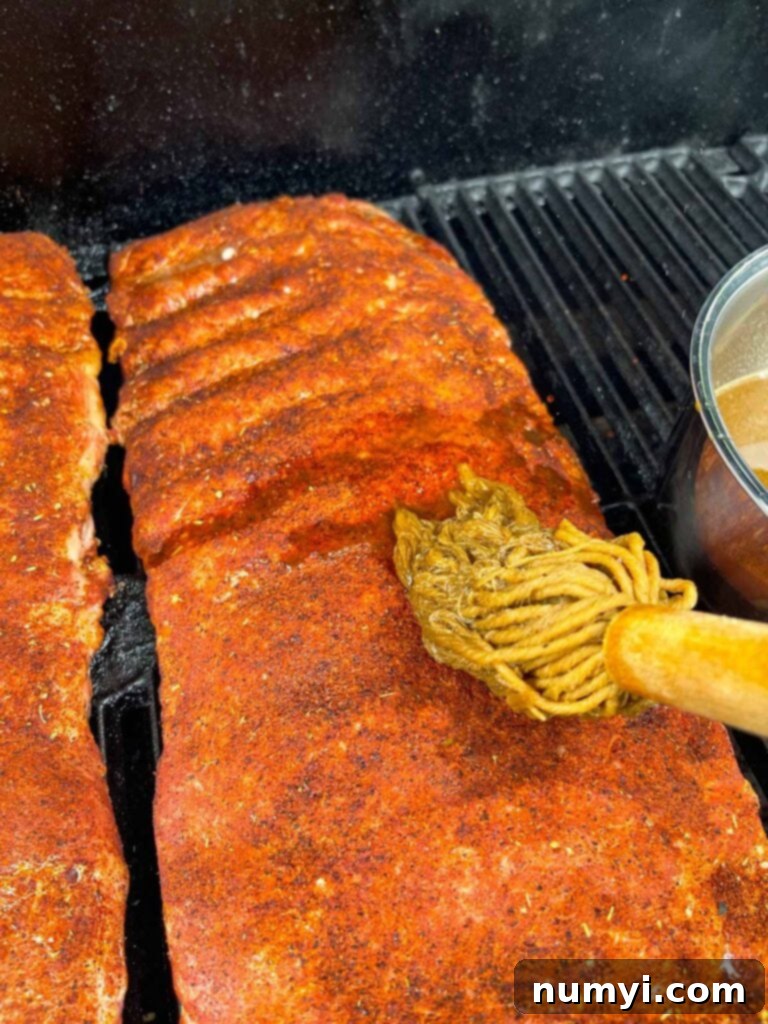
After the first 30 minutes of smoking, it’s time to begin the mop-basting process. Gently and evenly apply the warm mop sauce to the ribs. Repeat this step every 30 minutes throughout the entire smoking duration. This continuous basting not only adds layers of flavor but also helps to keep the surface of the ribs moist, promoting a desirable bark without drying out the meat. To ensure an even cook and consistent color, it’s also a good practice to rotate your ribs every hour or so, especially if your smoker has hot spots.
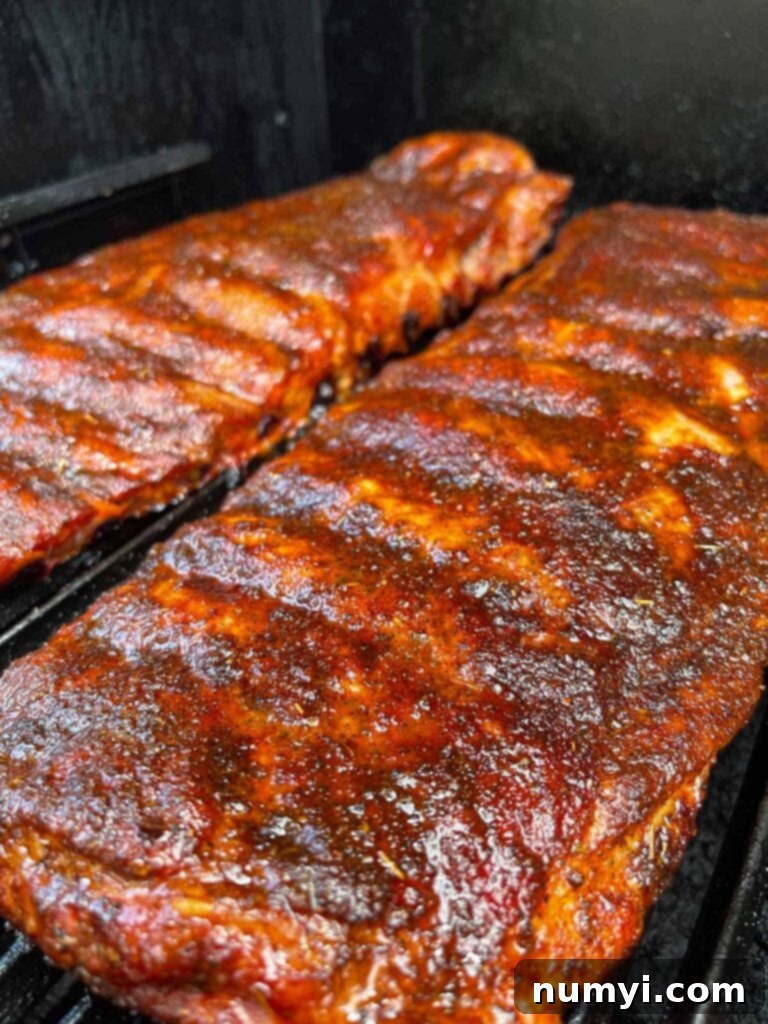
Continue to smoke and mop the ribs, monitoring your smoker’s temperature to keep it consistent. After the ribs have been on the smoker for approximately 3 hours, start checking their internal temperature with a reliable instant-read thermometer. This is where the art of barbecue meets the science of cooking. Insert the thermometer into the thickest part of the meat, avoiding the bone.
For what I consider the perfect texture – a tender, juicy rib with a satisfying clean bite and minimal tug – aim for an internal temperature of around 195°F. If you prefer a rib with a bit more chew or tug, you can pull them off slightly earlier, perhaps around 185-190°F. Conversely, if you’re chasing that “fall-off-the-bone” experience (though this method aims for a clean bite), a slightly higher temperature, closer to 200-205°F, will achieve that. However, I strongly advise against cooking them over 205°F, as they can quickly become dry and mushy, nor below 185°F, as the collagen won’t have fully broken down. The key is to test for tenderness by gently probing the meat with your thermometer or a toothpick; it should slide in with little resistance, like soft butter.
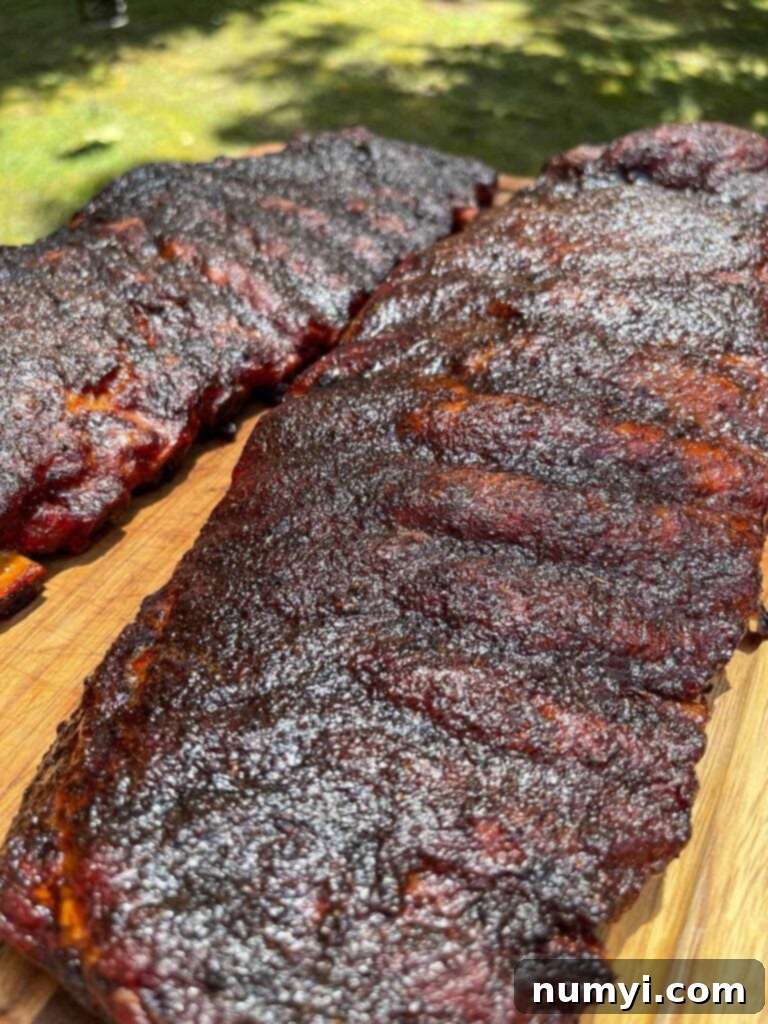
Once your ribs reach the desired internal temperature and tenderness, carefully remove them from the smoker. Place them on a cutting board and allow them to rest uncovered for approximately 15 minutes. This resting period is crucial; it allows the juices within the meat to redistribute, resulting in a significantly more tender and succulent rib. Skipping this step can lead to juices running out onto the board when you slice, leaving you with drier ribs.
Step 6: Slicing and Enjoying Your Smoked Ribs
After patiently waiting for your ribs to rest, it’s time for the gratifying final step: slicing and serving. The easiest and most effective way to cut your smoked ribs is to flip them bone-side up on your cutting board. Using a long, sharp knife, carefully slice cleanly between each bone. This ensures each serving is a perfectly portioned, meaty rib.
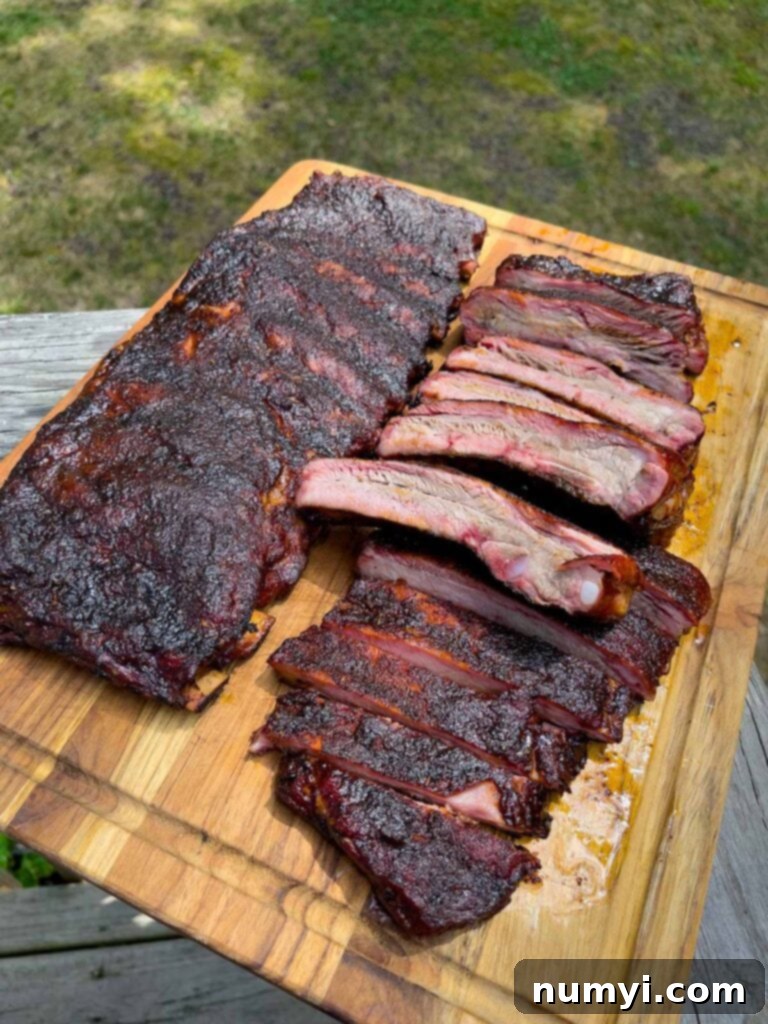
As you slice, you’ll be rewarded with a visual feast: a prominent, beautiful smoke ring just beneath the bark, indicating perfectly smoked meat, and a glistening, juicy interior. The aroma alone will confirm that your efforts have paid off.
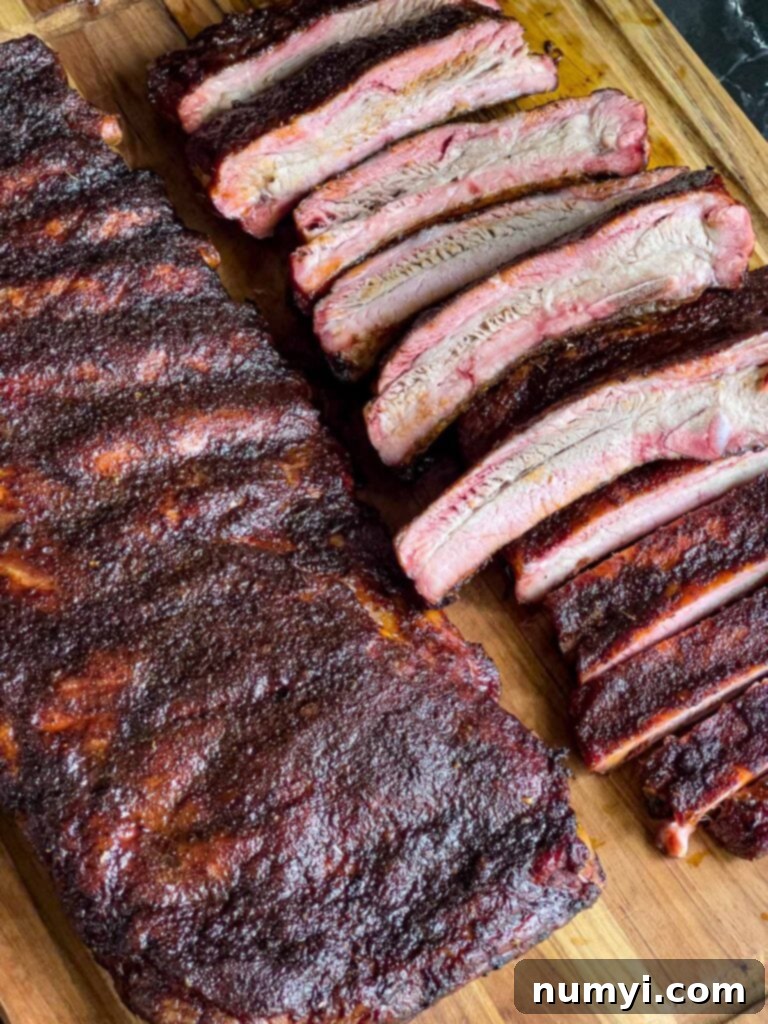
Arrange your perfectly sliced ribs on a platter and serve them with your favorite barbecue side dishes. For an unforgettable meal, consider pairing them with our creamy Baked Macaroni And Cheese or our hearty Easy Barbecue Baked Beans Recipe. Both are delightful complements that will elevate your barbecue spread.
Seriously, these smoked St. Louis ribs are among the best you’ll ever experience. And the best part? The process is surprisingly straightforward, especially with our no-wrap, mop-basting method. Forget complex techniques or endless fuss; it’s just pure, unadulterated, fantastic barbecue!
Other Delicious Barbecue Dishes to Explore
Smoked Baby Back Ribs Recipe
Central Texas Style Smoked Brisket
Fall-Apart Smoked Chuck Roast Recipe
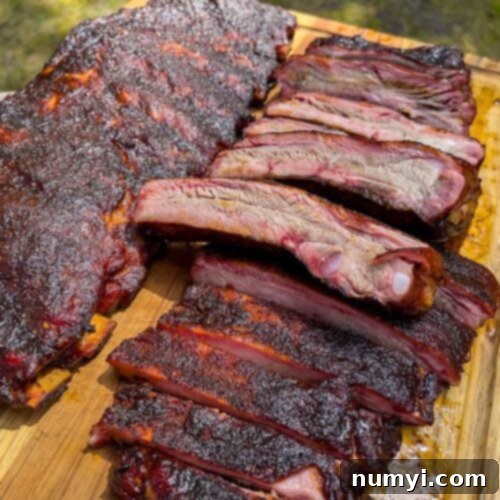
St. Louis Ribs – Learn How To Do Smoked Ribs Like A Pro
Print
Pin
Rate
Equipment
-
Smoker
Ingredients
The Ribs
- 2 racks Pork Spareribs cut to St. Louis Style (approx. 2.5-3 lbs each)
The Rub
- 1/2 cup Paprika
- 2 tbsp Smoked paprika
- 2 tbsp Garlic powder
- 1/4 cup Chili powder
- 3 tbsp Kosher salt
- 3 tbsp Black pepper
- 2 tbsp Onion powder
- 3 tbsp Brown sugar
- 1 tbsp Dried oregano
- 1 tbsp Cumin
- 2 tsp Dry mustard
- 1 tsp Cayenne powder
The Mop
- 3/4 cup Worcestershire sauce
- 2 tbsp Apple cider vinegar
- 6 tbsp Butter
- 1 tbsp Black pepper
- 2 tsp Kosher salt
Instructions
Preparing The Rub
-
Combine all rub ingredients in a bowl. Whisk thoroughly to combine well. Transfer to a spice shaker or set aside.
Preparing The Ribs
-
Trim excess fat and any loose bits off of both sides of the ribs for an even cook and bark development.
-
Flip the ribs to the bone side. Locate and trim off the diaphragm flap of meat (if present), as it cooks faster than the main rack.
-
Carefully remove the silver skin (membrane) from the bone side of the ribs for better rub penetration and a tender bite.
-
If starting with spareribs, cut them down to St. Louis Style by removing the brisket bone and rib tips, creating a rectangular rack.
-
Liberally apply your prepared rub to both sides of the ribs, patting it gently to ensure it adheres. Let the ribs sit at room temperature for 30-60 minutes before smoking.
Preparing The Mop
-
Combine all mop ingredients in a saucepan. Warm gently over low heat until butter is melted, then keep warm throughout the smoking process.
Smoking The Ribs
-
Preheat your smoker to a consistent temperature between 250 degrees F and 275 degrees F. Add your preferred wood for smoking.
-
Place the ribs in the smoker bone side down, orienting thicker sides towards the main heat source for even cooking.
-
Smoke the ribs for three hours, gently mopping both sides of the ribs every 30 minutes. Consider rotating the racks hourly for consistent exposure to heat and smoke.
-
After three hours, begin checking for doneness. Use an instant-read meat thermometer inserted into the thickest part of the meat (avoiding bone) to monitor internal temperature.
-
Remove the ribs from the smoker when the internal temperature reaches approximately 195 degrees F for a clean bite. For more tug, aim for 185-190°F.
-
Allow the ribs to rest uncovered on a cutting board for 15 minutes to allow juices to redistribute.
-
Turn the ribs over (bone side up) and make clean cuts between each of the bones using a sharp knife.
-
Serve immediately with your favorite barbecue sides and enjoy the perfectly smoked, tender ribs!
Notes
The mop recipe yields about 2 cups of sauce. You should use a little more than half of this amount on two racks of ribs during the basting process.
A note on internal meat temperatures for ribs: 195°F will give you a satisfying, clean bite with a gentle tug. A slightly lower temperature (185-190°F) will produce a bit more resistance and tug on the rib. Conversely, a higher temperature (200-205°F) will result in a “fall off the bone” experience, where the meat pulls away effortlessly.
For best results, I would not cook St. Louis ribs over 205°F to avoid them becoming mushy or dry, nor lower than 185°F to ensure proper collagen breakdown and tenderness.
